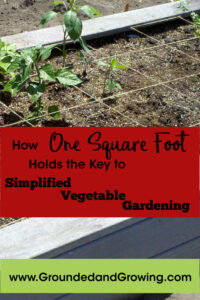 Square foot gardening is an easy maintenance way to provide home grown vegetables for your family even when you’re short on space and time.
Square foot gardening is an easy maintenance way to provide home grown vegetables for your family even when you’re short on space and time.
This post contains affiliate links for your shopping convenience.
When I say “vegetable garden” what comes to mind?
If you grew up anything like I did, the vegetable garden was a relatively large space, about 35′ x 35′ full of 35 foot rows of plants lined up single file. And weeding. Lots and lots of weeding. If we dared to mutter the phrase “I’m bored” to my mom during the summer, we usually ended up being told to weed the vegetable garden.
It’s honestly a miracle that I still love gardening. I guess that’s a sign that it truly is one of my passions.
My dad always planted pretty much the same things, in pretty much the same way. Long, single file rows. Doing anything differently was just not an option in his mind.
Then there was a span of several years where he was working a lot more than usual and really didn’t set foot in the garden. I was in high school and college at the time, and saw my chance to experiment.
I did things like plant an herb garden and a perennial border in the vegetable garden.
*GASP*
Yeah I was a really rebellious teen.
But I also started experimenting with something I’d read about called square foot gardening. And it changed the way I gardened from that point forward. It’s how I garden today, 25+ years later.
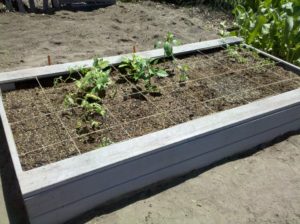
It helps to actually mark the square foot sections in your square foot garden, at least the first few times you plant this way. In this garden we used nails along the edge and garden twine to make our grid. There are grids available specifically for square foot gardening, but most people have something already on hand that does the job nicely such as bamboo, wooden slats, or old miniblinds. You just need to be able to mark the grid clearly in the garden.
The basic layout for square foot gardening is to divide your garden into a grid with 1′ x 1′ squares. Each square is treated as an individual unit, and planted at different plant densities depending on the crop. The plants are not in a single file line, instead they’re spaced to fill the square.
If you’ve always wanted a vegetable garden but don’t know where to start, I wrote this post awhile back with some questions to consider. If you’re wanting to do an in-ground or raised bed garden, I recommend the square foot gardening method hands down. Starting with a 4′ x 4′ raised bed or plot is a great first-time garden size. It’s small enough to be easily managed, but big enough for a substantial harvest for your family.
Why grow a square foot garden?
Less Weeds–
This is probably my #1 reason I love this method so much. Beyond a few weeds here and there in the beginning of the season, I do not weed my vegetable garden. At all. Since the plants are growing close together, the soil is shaded and most weeds don’t grow.
Less Space Needed–
If you wanted to, you could plant every one foot square with a different crop. With square foot gardening, you can squeeze a remarkable variety of crops into a small space. For example a 4′ by 8′ garden space has 32 square foot sections to plant. That’s a lot of variety in a small space.
Many people start out with a 4′ x 4′ garden, so only 16 squares to plant. Generally square foot gardens are a max of 4 feet across because that’s a distance you can comfortably reach across and not worry about trying to walk in between plants that are growing close together.
Adapts to Many Gardens–
The Square Foot Gardening book centers around planting in raised beds, but you can apply the same concepts to planting in the ground or in containers. Just measure out your planting area in the ground, or calculate the square footage of your container. (Area of a circle = π(radius)² and one square foot= 144 square inches)
Don’t hate me because I adapt Square Foot Gardening to my garden!
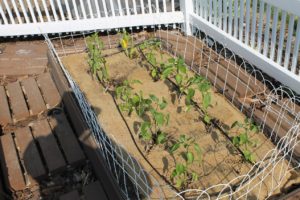
Peppers in our raised bed planted according to Square Foot Gardening techniques (1 plant per square foot). That year we used an old burlap sack for weed suppression. Also note the black tubing for our drip irrigation system.
If you read online Facebook or other discussion groups about Square Foot Gardening, you will find a lot of very dedicated gardeners there. Some of them are almost religious about their square foot gardens.
One group I was reading ganged up on people that didn’t follow the Square Foot Gardening book to the letter. I saw people being accused of not being “true” Square Foot Gardeners. So I’m sure they won’t like it that I’m telling you to adapt the method to whatever sort of garden you have.
I’ll also be blasphemous and tell you that if you use a raised bed, you don’t need to use the Mel’s Mix (equal parts peat/compost/vermiculite) touted in the book and all over the online groups. I made Mel’s Mix a few years back for an Extension demonstration garden project. Buying the quantities needed to fill our 4′ by 8′ bed got expensive in a hurry (mostly because of needing mass quantities of vermiculite). Also, it was a challenge to create the mix and get it in the beds. When we did it we mixed everything on a blue tarp and shoveled it into the beds. It was a lot of steps and quite a production.
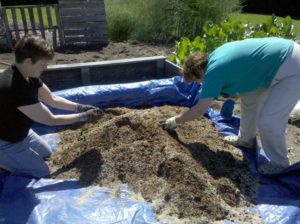
Mixing up “Mel’s Mix” for our 4′ x 8′ Square Foot Garden was a lot more work than we anticipated.
In the meantime, at my house we’ve had raise beds for years, and we filled them partially with the soil that we had already been improving for years. We mixed in various bagged planting mixes for vegetable gardens and raised beds. We also use our worm compost and any used planting mix from the previous year’s containers.
When we used Mel’s Mix in our square foot gardens, the beds were gorgeous and nearly weed-free. But since Mel’s Mix is extremely well-draining, they also needed a lot more water than we anticipated. Despite the peat and compost in the mix, it just didn’t hold water well, especially in the heat of the summer.
My raised beds at home drain well, but they don’t dry out as fast. This means much happier plants, and less stressed gardeners! Save yourself the trouble and use bagged garden or raised bed mix. Just don’t tell the online Square Foot Gardening people or they may shun you!
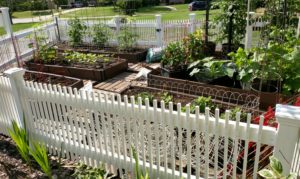
Our garden (2018): a mix of raised beds planted with Square Foot Gardening Techniques and containers.
My Favorite Resources
** Resources in green are affiliate links for your shopping convenience.
Square Foot Gardening book— The third edition of the Square Foot Gardening book was released in 2018. It’s a handy reference for how to plant just about any crop you can think of in the Square Foot Gardening method. This is a book you should be able to find used very easily. I feel like I’ve seen it at every second hand book store I’ve ever visited!
Square Foot Gardening Foundation— Subscribe to the Square Foot Gardening newsletter and read about global humanitarian efforts to combat hunger through Square Foot Gardening. There are also some useful soil calculator tools here. I found this site with a handy online reference for planting densities for different crops.
Square Foot Garden tool— My husband found this tool online. We tried it in the garden this year and it is very easy to use and eliminates fumbling around and guessing distances for planting.
Raised bed kits— I used the Square Foot Gardening method in the ground for years before we built raised beds. Raised beds are an investment. But having gardened both ways, I prefer raised beds. They make gardening so much easier. I never have to till them, they warm up quickly in the spring, and in a wet spring like we’ve had, they dry out quicker. You can find just about any style of raised bed through the above link. We used composite lumber made from recycled plastic for our beds and they look as good today as they did when we built them almost 10 years ago. If kits aren’t your thing, I highly suggest at least buying corner brackets for your raised beds. They really do help hold the bed together more effectively than just nailing or screwing the boards together.
Drip Irrigation— Adding drip irrigation to our vegetable garden was a game changer. Watering was the one remaining hurdle to making our garden as easy maintenance as possible. We have used a couple of different brands, but they all connect to your garden hose and you can add a timer as well– so you don’t have to remember to turn the water on or off (I may have left the hose on overnight a time or two before we used a timer).
If you liked this post, please subscribe to Grounded and Growing today and receive your copy of “15 Tips to Become a '15 Minute Gardener'” so you can spend less time working ON your garden and more time enjoying being IN your garden.! It’s absolutely free. When you join the Grounded and Growing community, you’ll finally take the garden off your “To-Do” list and allow yourself time to enjoy your garden and savor the peace and serenity there. I tell subscribers about new posts as soon as I hit ‘publish’ and send weekly-ish updates on what’s going on in my garden– good, bad AND ugly.

All Rights Reserved. © 2019 Jennifer Schultz Nelson.
[…] walk in them, making tilling unnecessary. They also lend themselves to intensive planting like Square Foot Gardening, so we can harvest more than enough produce for our 4-member family in a relatively small […]